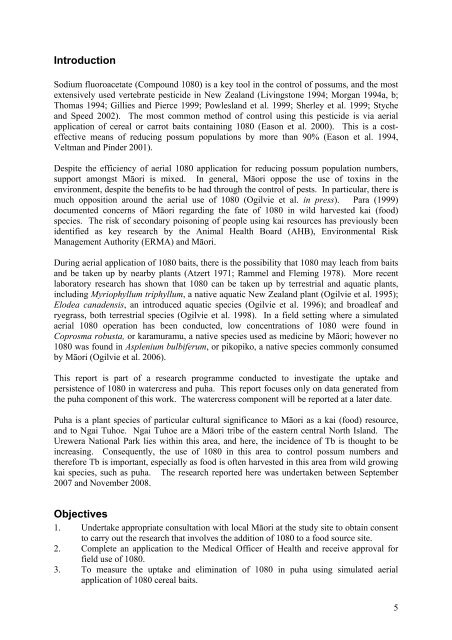Sodium Fluoroacetate (compound 1080) - Lincoln University ...
Sodium Fluoroacetate (compound 1080) - Lincoln University ...
Sodium Fluoroacetate (compound 1080) - Lincoln University ...
Create successful ePaper yourself
Turn your PDF publications into a flip-book with our unique Google optimized e-Paper software.
Introduction<br />
<strong>Sodium</strong> fluoroacetate (Compound <strong>1080</strong>) is a key tool in the control of possums, and the most<br />
extensively used vertebrate pesticide in New Zealand (Livingstone 1994; Morgan 1994a, b;<br />
Thomas 1994; Gillies and Pierce 1999; Powlesland et al. 1999; Sherley et al. 1999; Styche<br />
and Speed 2002). The most common method of control using this pesticide is via aerial<br />
application of cereal or carrot baits containing <strong>1080</strong> (Eason et al. 2000). This is a costeffective<br />
means of reducing possum populations by more than 90% (Eason et al. 1994,<br />
Veltman and Pinder 2001).<br />
Despite the efficiency of aerial <strong>1080</strong> application for reducing possum population numbers,<br />
support amongst Māori is mixed. In general, Māori oppose the use of toxins in the<br />
environment, despite the benefits to be had through the control of pests. In particular, there is<br />
much opposition around the aerial use of <strong>1080</strong> (Ogilvie et al. in press). Para (1999)<br />
documented concerns of Māori regarding the fate of <strong>1080</strong> in wild harvested kai (food)<br />
species. The risk of secondary poisoning of people using kai resources has previously been<br />
identified as key research by the Animal Health Board (AHB), Environmental Risk<br />
Management Authority (ERMA) and Māori.<br />
During aerial application of <strong>1080</strong> baits, there is the possibility that <strong>1080</strong> may leach from baits<br />
and be taken up by nearby plants (Atzert 1971; Rammel and Fleming 1978). More recent<br />
laboratory research has shown that <strong>1080</strong> can be taken up by terrestrial and aquatic plants,<br />
including Myriophyllum triphyllum, a native aquatic New Zealand plant (Ogilvie et al. 1995);<br />
Elodea canadensis, an introduced aquatic species (Ogilvie et al. 1996); and broadleaf and<br />
ryegrass, both terrestrial species (Ogilvie et al. 1998). In a field setting where a simulated<br />
aerial <strong>1080</strong> operation has been conducted, low concentrations of <strong>1080</strong> were found in<br />
Coprosma robusta, or karamuramu, a native species used as medicine by Māori; however no<br />
<strong>1080</strong> was found in Asplenium bulbiferum, or pikopiko, a native species commonly consumed<br />
by Māori (Ogilvie et al. 2006).<br />
This report is part of a research programme conducted to investigate the uptake and<br />
persistence of <strong>1080</strong> in watercress and puha. This report focuses only on data generated from<br />
the puha component of this work. The watercress component will be reported at a later date.<br />
Puha is a plant species of particular cultural significance to Māori as a kai (food) resource,<br />
and to Ngai Tuhoe. Ngai Tuhoe are a Māori tribe of the eastern central North Island. The<br />
Urewera National Park lies within this area, and here, the incidence of Tb is thought to be<br />
increasing. Consequently, the use of <strong>1080</strong> in this area to control possum numbers and<br />
therefore Tb is important, especially as food is often harvested in this area from wild growing<br />
kai species, such as puha. The research reported here was undertaken between September<br />
2007 and November 2008.<br />
Objectives<br />
1. Undertake appropriate consultation with local Māori at the study site to obtain consent<br />
to carry out the research that involves the addition of <strong>1080</strong> to a food source site.<br />
2. Complete an application to the Medical Officer of Health and receive approval for<br />
field use of <strong>1080</strong>.<br />
3. To measure the uptake and elimination of <strong>1080</strong> in puha using simulated aerial<br />
application of <strong>1080</strong> cereal baits.<br />
5

















